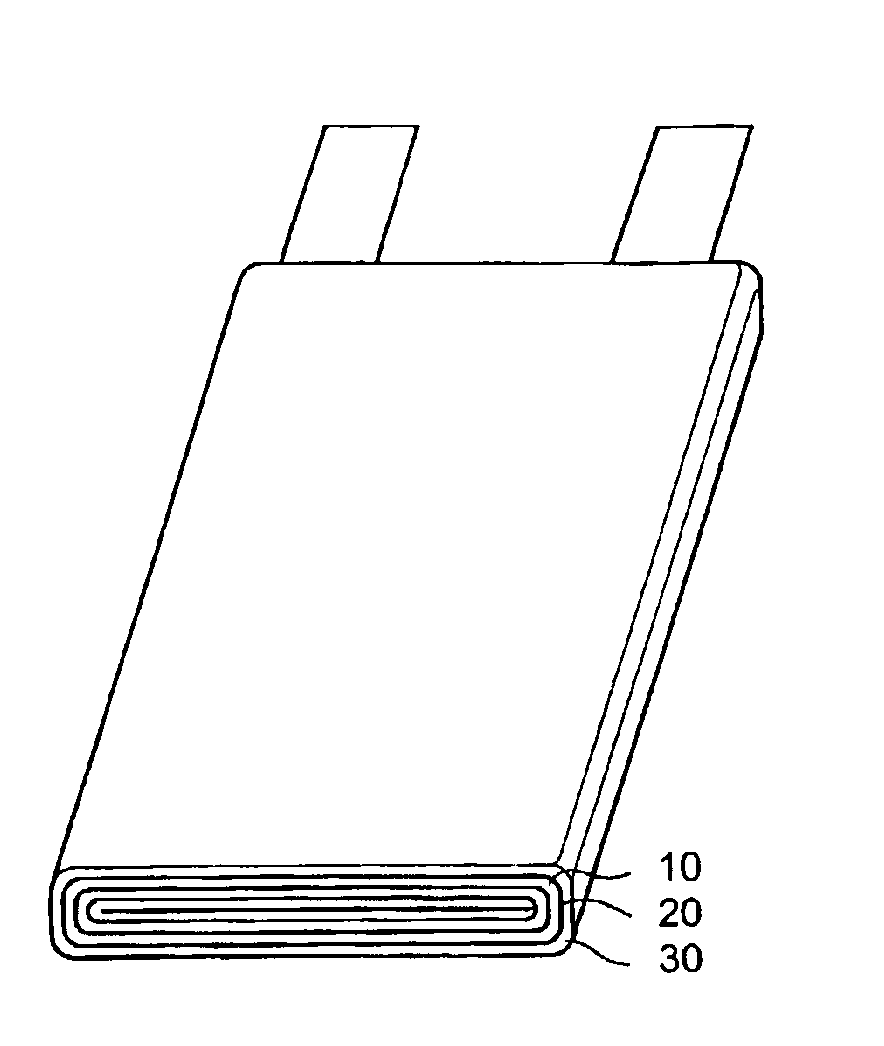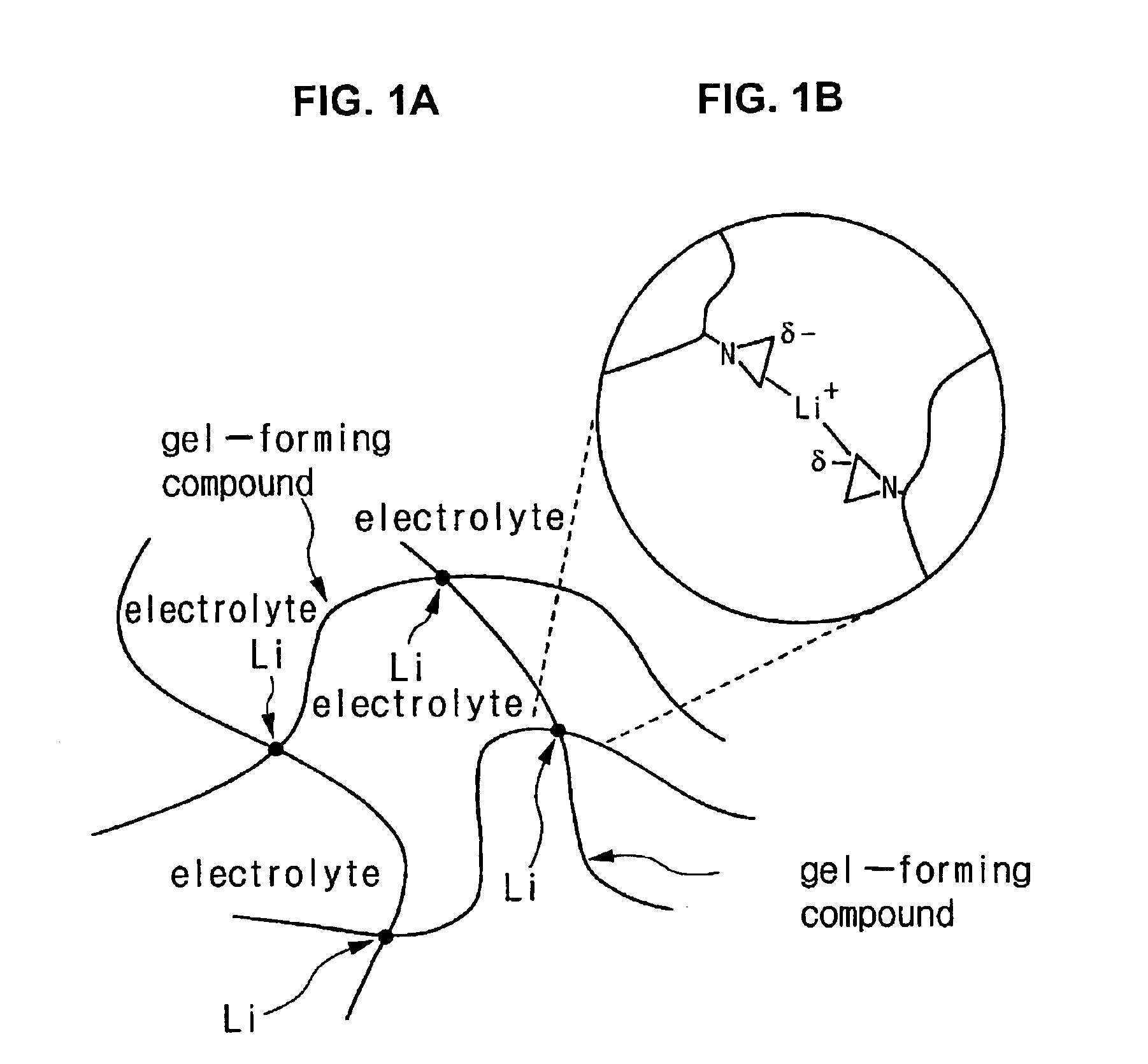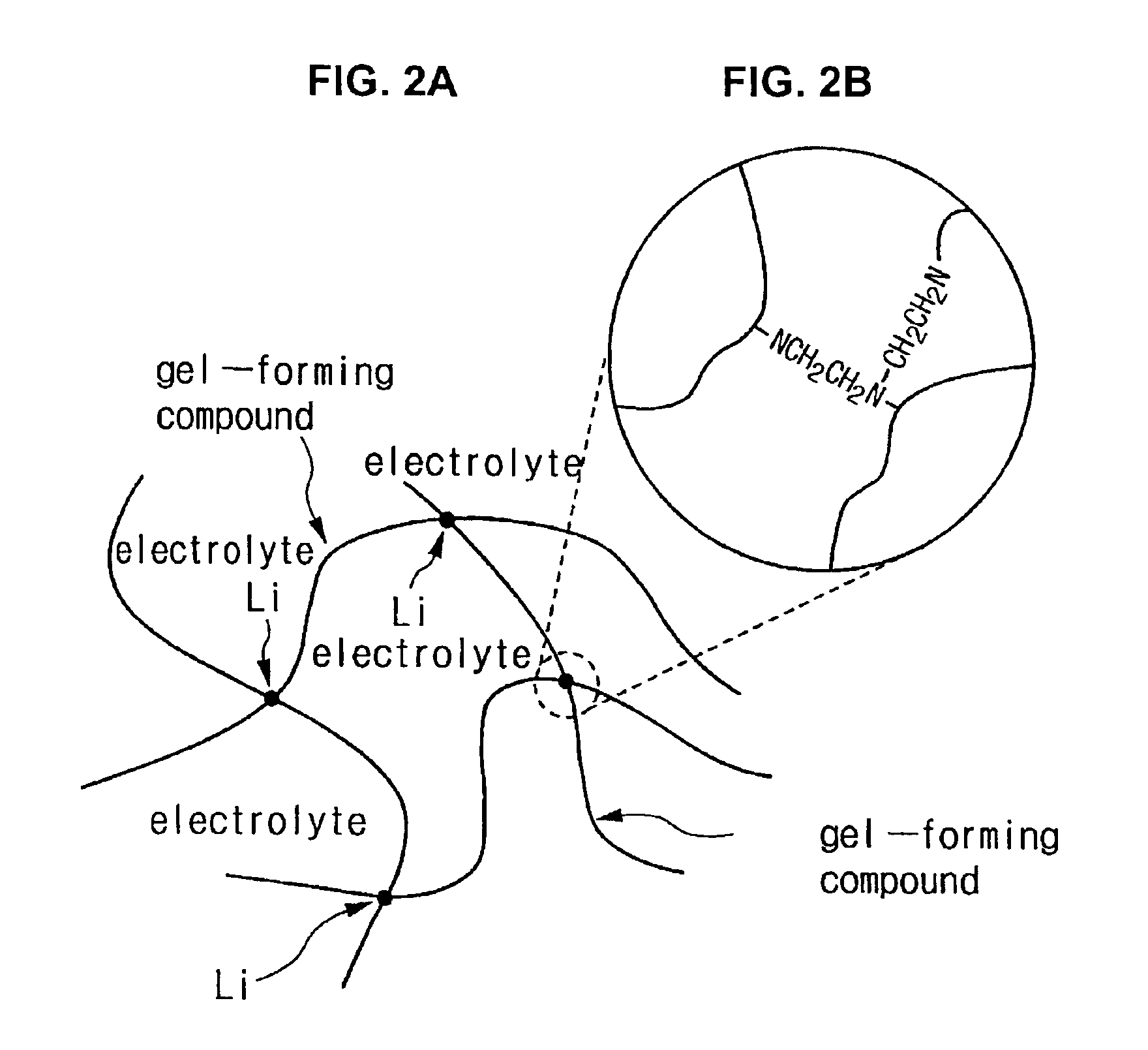Polymer electrolyte and a lithium secondary battery having the same
a lithium secondary battery and polymer electrolyte technology, applied in the direction of non-aqueous electrolyte cells, cell components, sustainable manufacturing/processing, etc., can solve the problems of negative influence on the charge and discharge reaction of the battery, negative electrode short circuit, electrolyte not formed, etc., to achieve stable battery existence
- Summary
- Abstract
- Description
- Claims
- Application Information
AI Technical Summary
Benefits of technology
Problems solved by technology
Method used
Image
Examples
example 1 through 10
[0096]TAZM (trimethylolpropane-tri-β-aziridinylpropionate) as shown in the following Formula 5 was prepared as the gel-forming compound. The TAZM is the material of Formula 1 wherein R1 is CH3, and R2 is H.
[0097]Samples 1 to 10 comprising TAZM at 2.5 to 10 wt % were fabricated by adding the TAZM to the following three kinds of organic electrolytes, sufficiently agitating the Samples 1 to 10, and then leaving the Samples 1 to 10 under various conditions. The following Table 1 shows the test results of the ion conductivity of the Samples 1 to 10.
[0098]The three kinds of organic electrolytes are as follows:
[0099]Organic electrolyte 1: EC:DMC:DEC=3:3:1 (volume ratio);
[0100]Organic electrolyte 2: EC:DMC:DEC=3:3:1 (volume ratio)+LiPF6(1.0 mol / L); and
[0101]Organic electrolyte 3: EC:DMC:DEC=3:3:1 (volume ratio)+LiPF6(1.3 mol / L),
[0102]where EC means Ethylene Carbonate, DMC means Dimethyl Carbonate, and DEC means Diethyl Carbonate.
[0103]Also, the leaving conditions were three kinds: one was ...
example 11 to 12
[0107]TAZM (trimethylolpropane-tri-β-aziridinylpropionate) as shown in the following Formula 5, and Me-TAZM as shown in the following Formula 6, were prepared as the gel-forming compounds. The Me-TAZM was the material of Formula 1 wherein R1 and R2 are all CH3
[0108]Samples 11 and 12 comprising the TAZM or the Me-TAZM at 10 wt % were fabricated by the following procedures: adding the TAZM or the Me-TAZM to the organic electrolyte 2, sufficiently agitating Samples 11 and 12, and leaving the samples under the condition of room temperature for 15 hours. The following table 2 shows the test results of the ion conductivity of Samples 11 and 12.
[0109]
TABLE 2SampleGel-forming compoundIon conductivitySample 11TAZM3.0 mS / cmSample 12Me-TAZM2.5 mS / cm
[0110]As shown in table 2, Samples 11 and 12 were gelated under the leaving condition of room temperature for 15 hours. Also, the ion conductivity of the gelated Samples 11 and 12 was 2.5 to 3 mS / cm, and therefore the ion conductivity of the gelate...
example 13
[0112]Example 13 reveals the discharge curve of the lithium secondary battery cell comprising the electrolyte of Sample 7. A coin-type battery cell was fabricated by the following procedures: inserting a positive electrode 30, a porous polypropylene separator 20, and packing into a positive electrode case; inserting the polymer electrolyte (Sample 7) into the positive electrode case; sealing the entrance of the positive electrode case with a negative electrode 10 and a negative electrode cover; and leaving the positive electrode case for 24 hours at room temperature. The diameter of the coin-type battery cell was 20 mm, and the height was 1.6 mm (CR2016).
[0113]The charge condition was as follows: the battery cell was charged until the voltage reached 4.2V with a constant 0.2C current, and then it was charged for 9 hours at 4.2V. That is, the charge condition was a constant current-constant voltage charge. The discharge condition was as follows: the battery cell was discharged until ...
PUM
| Property | Measurement | Unit |
|---|---|---|
| Volume | aaaaa | aaaaa |
| Weight | aaaaa | aaaaa |
| Concentration | aaaaa | aaaaa |
Abstract
Description
Claims
Application Information
 Login to View More
Login to View More - R&D
- Intellectual Property
- Life Sciences
- Materials
- Tech Scout
- Unparalleled Data Quality
- Higher Quality Content
- 60% Fewer Hallucinations
Browse by: Latest US Patents, China's latest patents, Technical Efficacy Thesaurus, Application Domain, Technology Topic, Popular Technical Reports.
© 2025 PatSnap. All rights reserved.Legal|Privacy policy|Modern Slavery Act Transparency Statement|Sitemap|About US| Contact US: help@patsnap.com



